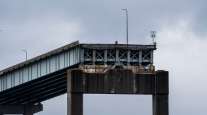Is Bad GPS Causing Trucks to Hit Low Bridges in New York Town?
In a bizarre turn of events, a second tractor-trailer hit a low railroad overpass in Glenville, New York, on Nov. 28, just hours after a similar incident at the rail bridge on Glenridge Road.
The incident, which happened at about 6:30 p.m. at the 10-foot-clearance Maple Avenue bridge, did far more damage to the truck involved than the earlier incident, causing the trailer top to fold.
The two accidents, which didn't involve injuries, renewed existing questions about why tractor-trailers are hitting the local railroad bridges — admittedly low-clearance ones — more often.
Is GPS at fault for repeated #Glenville railroad bridge accidents? https://t.co/cwqiFwr7eU pic.twitter.com/oCQba20rfE
— Daily Gazette (@dgazette) November 30, 2016
Quite possibly, the drivers were relying on navigation GPS devices that didn't include low-bridge warnings, officials said they believe.
"I'm at a loss," Glenville Town Supervisor Chris Koetzle said. "It just seems to be that people are coming through and not paying attention because they're looking at their GPS."
It is not clear whether GPS — the common acronym for global positioning systems — are actually at fault in either case, but basic GPS systems do not include such information as low-bridge warnings.
Federal highway standards require bridges to have at least 13 feet and 6 inches of clearance for truck safety, but old railroad bridges on local road systems often fall short of that standard.
On both Glenridge Road and Maple Avenue, there are multiple warning signs about the low-height overpass ahead. Koetzle said adding more warning signs is unlikely to help.
This is just one of TWO #Glenville low RR bridges hit by trucks on Monday: https://t.co/x0MjMJEavJ — Stephen Williams (@gazettesteve) November 29, 2016
The Glenridge Road bridge, which has a clearance of 10 feet and 11 inches, has been struck at least 20 times since a road-widening project was finished in 2013, with the tops sometimes being peeled off of trucks.
The Maple Avenue bridge, which has a narrow width as well as a clearance of only 10 feet, doesn't have a prior record of being struck. The truck that hit it suffered serious damage that required closing down Maple Avenue during the evening commuting hours.
"I'm told by people who were there that the GPS were active," Koetzle said. "People have to understand where the low bridges are if they are going to drive professionally. [Police Chief Stephen Janik] was shocked; he said they just seem to be following the GPS blindly."
Neither trucking company involved in the Nov. 28 incidents — one based in Texas, the other based in Quebec — was willing to comment on what had happened when contacted Nov. 29.
But a spokesman for the U.S. Department of Transportation's Federal Motor Carrier Safety Administration confirmed that there is a known problem with truckers using inadequate GPS systems that lead them to hit obstructions like bridges.
"The fact they may be using nonprofessional GPS systems may be the dynamic in play," spokesman Duane DeBruyne said. "As of January 2013, we developed a visor card that advised drivers to use professional-grade GPS so you are aware of things like low clearances."
He said FMCSA issues periodic reminders to the industry about relying on inadequate GPS systems, including using social media platforms like Facebook. A professional-grade system accepts information on a vehicle's height and weight before establishing a route and considers height and weight restrictions on roads.
"We are aware and we continue to be aware — we have been for a number of years — of a dynamic of drivers not using professional grade GPSs," DeBruyne said.
A spokesman for CP Rail, which owns the bridges, couldn't say whether truck strikes are occurring more frequently.
Railroad spokesman Andy Cummings said bridges are routinely closed to rail traffic after such incidents until a railroad inspector can determine whether the bridges are still safe.
"We can confirm the bridges were found to be safe and train traffic resumed following inspections in both cases," Cummings said.
Even before Nov. 28, town officials were saying the Glenridge Road bridge was being hit by trucks too often.
“It’s happened too many times,” Koetzle said Nov. 28, before the Maple Avenue crash occurred. “I’ve been on the phone with the railroad before, and I’ll be on the phone with them again. There has to be something more that can be done.”
State Department of Transportation spokesman Bryan Viggiani said there are proper warnings in place on Glenridge Road, if truckers heed them.
“Whether the driver is looking at GPS or at Google Maps at home when they plan their route, the bottom line is every motorist is responsible for following the signs," Viggiani said.
Distributed by Tribune Content Agency, LLC




